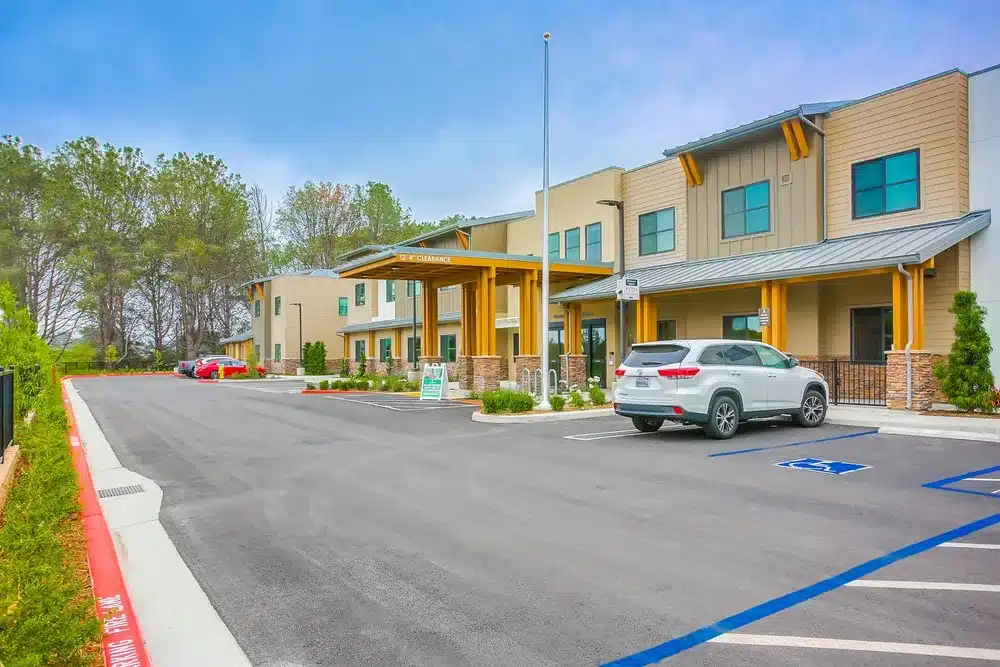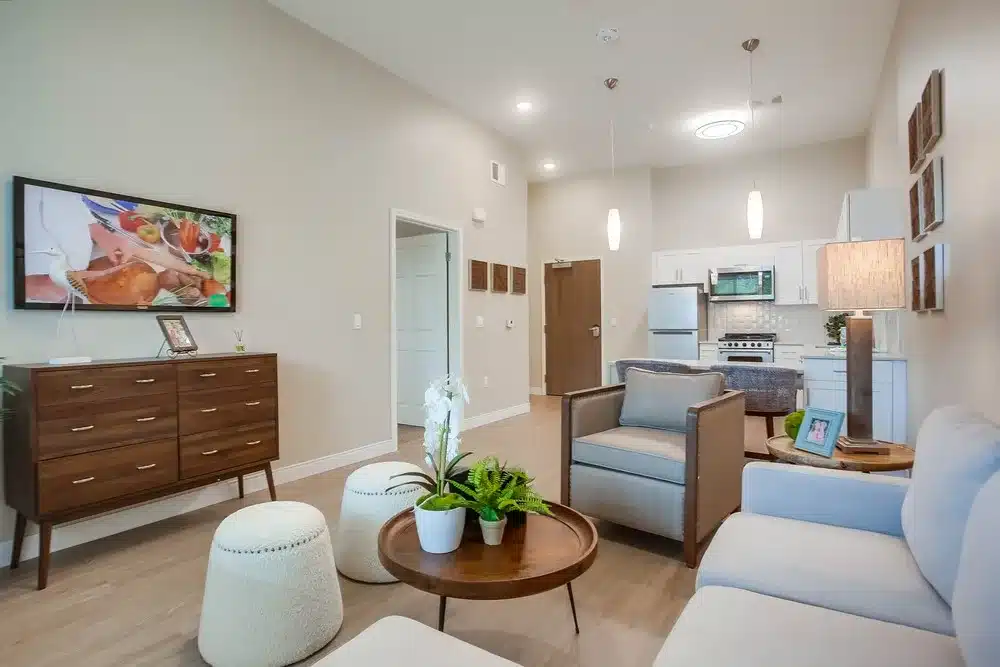Innovative Assisted Living Amenities Uncovered
Did you know that nearly 90% of seniors prefer to age in place, yet many find themselves seeking assisted living solutions?
This shift highlights the importance of innovative amenities that enhance comfort and promote independence.
At Westmont of Encinitas, we offer tailored support services and engaging social activities that reshape the senior living experience.
Discover what makes these amenities essential for fostering a thriving environment for seniors at Westmont of Encinitas.
What to Expect from Assisted Living Amenities: A Guide to Senior Comfort
When considering assisted living, you can expect various amenities to enhance your comfort and independence. These amenities play an important role in creating an environment that feels like home while supporting your daily needs. Options include various living arrangements, from respite care to memory care, ensuring tailored support. Essential services like housekeeping and laundry ease the process, allowing you to focus on self-care and personal interests. Social activities foster connections, promoting both mental and emotional well-being.
Additionally, transportation services enhance your mobility, ensuring access to community resources. These amenities contribute significantly to your quality of life, empowering you to thrive in a supportive and engaging atmosphere. You will also find personalized care services that cater to individual needs, ensuring that each resident receives the attention they deserve.
What Amenities Make Independent Living Feel Like Home?
To create a sense of home in independent living, amenities must prioritize comfort, convenience, and engagement. Essential services like housekeeping and laundry ease daily burdens, while on-site dining options foster community interaction. Additionally, wellness programs encourage physical activity and socialization. A qualified healthcare team ensures that residents receive personalized support, enhancing their overall quality of life.
| Amenities | Benefits | Purpose |
| Housekeeping | Maintains cleanliness | Reduces physical strain |
| Dining Services | Variety and choice in meals | Enhances social connections |
| Fitness Programs | Promotes physical well-being | Encourages active lifestyles |
| Recreation Activities | Provides mental stimulation | Fosters creativity and joy |
These thoughtful amenities enhance comfort and nurture a vibrant community atmosphere, making independent living feel like home.

How Senior Living Outdoor Amenities Enhance Well-Being
Outdoor amenities in senior living communities significantly contribute to residents’ overall well-being by providing physical activity, relaxation, and social interaction opportunities. These spaces, such as gardens and walking paths, encourage you to engage in exercise, promoting cardiovascular health and mobility. Relaxing outdoors can reduce stress and enhance mood, creating a peaceful retreat just steps away from home. Additionally, communal areas foster friendships and social bonds, which are essential for emotional support and mental health. Organized outdoor activities like group exercises or gardening clubs stimulate physical and cognitive skills, enriching your daily life. By prioritizing these outdoor spaces, senior living communities create supportive environments that nurture both body and spirit, enhancing overall quality of life. Furthermore, incorporating outdoor activities into daily routines can significantly boost residents’ emotional and mental well-being.
How to Pay for Assisted Living: Options and Resources
Steering the financial aspects of assisted living can feel overwhelming, but understanding your options and available resources can make the process more manageable. First, consider private funds, including savings and pensions, which provide flexibility. Long-term care insurance is another option, covering various services in assisted living. If eligible, Medicaid can help with costs, but it’s crucial to understand the specific requirements in your state. Veterans benefits may also assist eligible veterans and their spouses.
Some facilities offer financial assistance programs or sliding scale fees based on income. Exploring and discussing these avenues with a financial advisor can empower you to make informed decisions, ensuring your loved one receives the care they deserve without unnecessary financial strain. Furthermore, investigating government assistance programs can reveal additional support options tailored to your situation.
Pros and Cons of Assisted Living: Is It the Right Choice?
When considering assisted living, weighing the benefits and drawbacks is vital to determine if it’s the right choice for you or your loved one. Additionally, assisted living offers a supportive environment with access to healthcare, social activities, and amenities that promote independence. Residents often enjoy companionship, structured activities, and assistance with daily tasks, enhancing their quality of life.
However, it may come with a loss of independence and higher costs. Some individuals may feel isolated or uncomfortable in a communal setting. Assessing your loved one’s personal preferences, financial capacity, and specific needs is essential. By carefully evaluating these factors, you can make an informed decision about prioritizing their well-being and happiness.
In the tapestry of senior living, innovative amenities weave a vibrant thread of comfort and connection at Westmont of Encinitas. As you explore options, remember that each facility offers a unique blend of support and independence, allowing you to flourish in your golden years. With enhanced social activities, outdoor spaces, and tailored services at your fingertips, assisted living at Westmont can be a sanctuary where you thrive. Embrace the possibilities, and let this chapter of life unfold with joy and fulfillment. For more information, feel free to reach out at 760-452-6037.
How Do The Costs Of Moving Into A Quality Senior Care Community Compare With The Costs Of Staying At Home?Compare The Costs of Senior Living vs Staying at Home
Frequently Asked Questions
What services do most assisted living facilities provide?
Most assisted living facilities offer services to support residents’ daily needs while maintaining their independence. These typically include assistance with activities of daily living (ADLs) such as bathing, dressing, medication management, and mobility support. Facilities also provide meal services, housekeeping, laundry, transportation, and social activities to promote engagement and well-being. Depending on residents ‘ needs, some communities may offer additional healthcare services, memory care, or rehabilitation programs. The goal is to create a safe and comfortable environment that enhances quality of life.
What items should be excluded for residents at an assisted living facility?
Residents in assisted living should avoid bringing items that pose safety risks or violate facility policies. Commonly restricted items include open-flame candles, space heaters, and certain appliances that could be fire hazards. Facilities may also prohibit weapons, illegal substances, and excessive amounts of furniture that could clutter living spaces. In some cases, specific medications may need to be stored and administered by staff to ensure proper usage. It’s best to check with the particular community for a detailed list of prohibited items.
Do they do your laundry in assisted living?
Yes, most assisted living facilities provide laundry services as standard amenities. These typically include washing, drying, and folding personal clothing and linens. Some communities may have on-site laundry rooms for residents who prefer to do their laundry themselves. Staff members ensure that residents’ clothing is adequately cared for and returned to them. The frequency and cost of laundry services may vary depending on the facility.
What are the five levels of care in assisted living?
Assisted living care levels generally range from minimal assistance to extensive support based on residents’ needs. Level 1 (low care) involves minimal assistance with daily tasks, such as reminders and occasional support. Level 2 (moderate care) includes more frequent help with ADLs, mobility, and medication management. Level 3 (high care) provides hands-on assistance with most ADLs and more intensive supervision. Level 4 (advanced care) is for individuals with significant physical or cognitive impairments requiring specialized attention. Level 5 (memory care) is designed for residents with dementia or Alzheimer’s, offering structured routines and heightened security.








